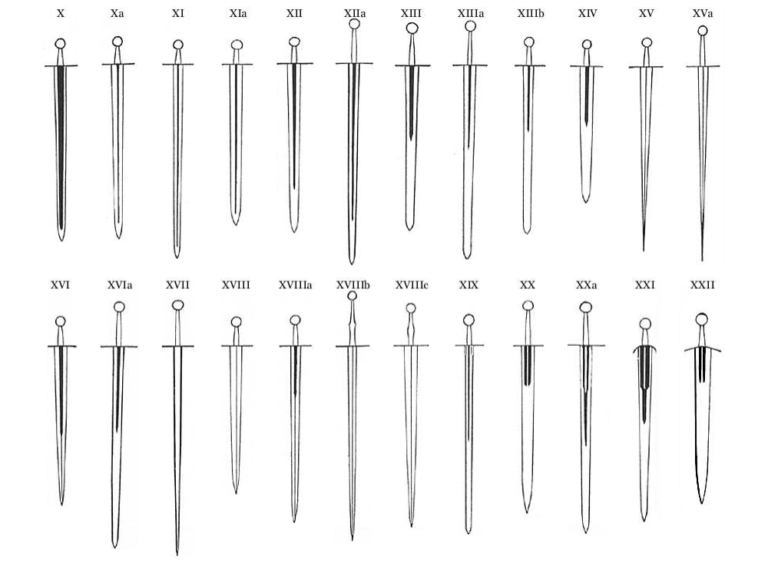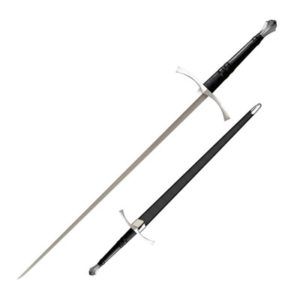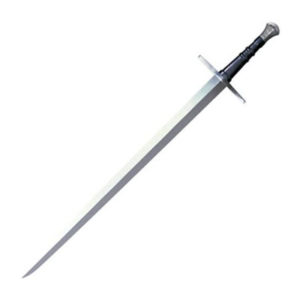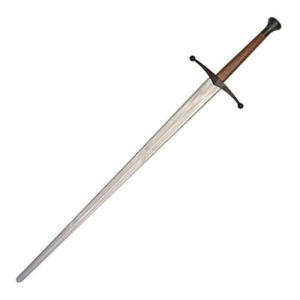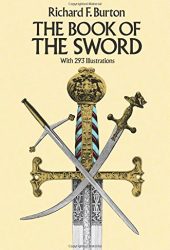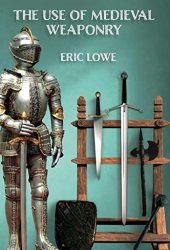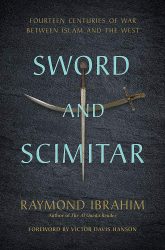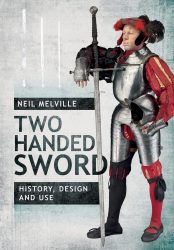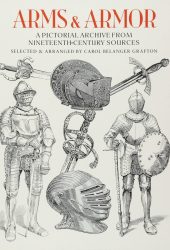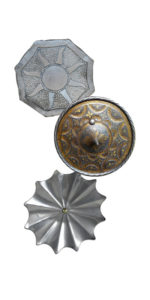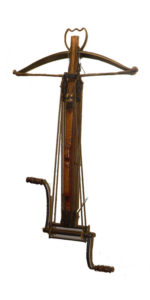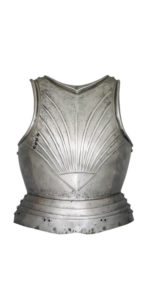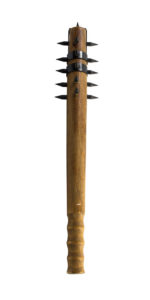The Longsword is a type of European sword used during the late medieval period. These swords have long cruciform hilts with grips over 10 to 15 inches in length, which provide room for two hands.
All parts of the sword are used for offensive purposes, including the pommel and crossguard. A powerful and versatile weapon, the longsword is used for hewing, slicing, and stabbing. The sword is commonly held in combat with both hands (although some may be used single-handed).
The blade of the sword is straight and predominantly double-edged. Blades differ considerably in cross-section, as well as in length and width. Various hilt styles exist, with the crossguard changing over time to accommodate different blade properties and stylistic trends.
History of the Longsword
The longsword appears to have become popular during the 14th century and remained in common use from 1250 to 1550.
Swords with exceptionally long hilts have been found throughout the High Middle Ages, but these remain rare. It was used as a military steel weapon of the earlier phase of the Hundred Years’ War. It was intended for wielders wearing full plate armor either on foot or on horseback throughout the late medieval period.
Distinct “bastard sword” hilt types developed during the first half of the 16th century in Bavaria and Switzerland. Greatsword and bastard-sword were also made in Spain, appearing relatively late.
Types of Longswords
- Longsword.
- Hand a Half Sword (or Bastard Sword)
Morphology
Types XIIa and XIIIa
Type XII typifies the classic knightly sword that developed during the age of the Crusades. These swords feature as a defining characteristic a long, wide blade with parallel edges, ending in a rounded or spatulate tip. The cross-guards are usually straight, and the pommels Brazil-nut or disk-shaped. Subtype XIIIa features longer blades and grips and corresponds to the knightly greatswords.
Types XVa
Type XVa is the classical two-handed sword of the 14th and 15th centuries. These swords have longer, narrower blades and grips sufficiently long for two-handed use. In contrast to type XIV, these are more greatly designed for thrusting above cleaving.
Types XVIa
The classical “longsword” of the 14th and 15th centuries. These swords have a longer blade with a shorter fuller (usually running down 1/3 and rarely exceeding 1/2 of the blade), and the grip is often extended to accommodate one and a half or two hands.
Types XVII
A shorter-lived type popular during the mid-14th to early 15th century. These swords are characterized by a long, evenly tapering blade, hexagonal cross-section, and a two-handed grip. They are suited toward thrusting. Some examples were found weighing more than 2 kg!
Types XVIIIb and XVIIIc
The later longswords of the mid-15th to early 16th centuries. These are tapering blades with a broad base, short grip, and diamond cross-section. Subtype XVIIIb are bastard swords with a longer blade and long grip, in use c. 1450 – c. 1520. Subtype XVIIIc has a shorter grip and a broad blade.
Types XX
These are broad blades with lenticular or octagonal cross-sections. This type includes the 14th to 15th century “hand and a half sword” or “two-handed” swords, often with two or more fullers. The edges of these blades are nearly parallel or only slightly tapered until reaching a final slope to a point.
Using Longswords
What we known about combat with the longsword comes from artistic depictions of battle from manuscripts of Medieval and Renaissance Masters.
The blade was generally used with both hands on the hilt, one resting close to or on the pommel. Half-swording was a manner of using both hands, one on the hilt and one on the blade, to better control the weapon in thrusts and jabs.
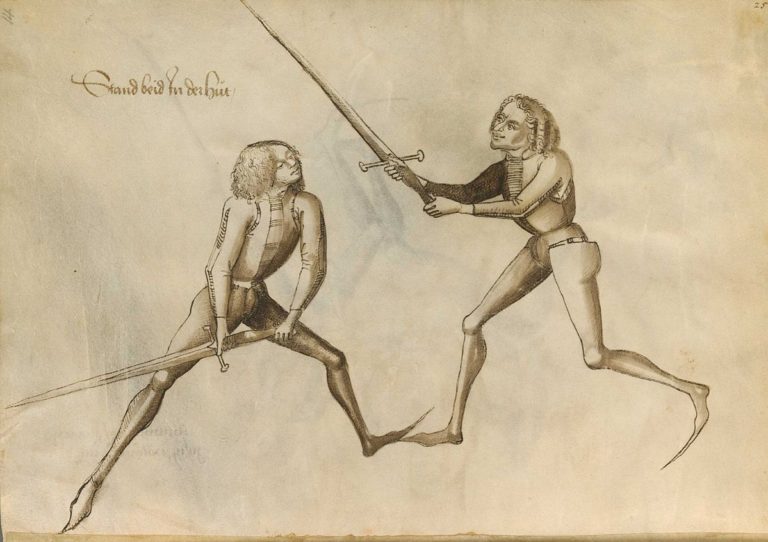

Codified fighting systems existed, with a variety of styles and teachers each providing a slightly different take on the art. Several Fechtbücher explains and depicts the use of the pommel and cross as offensive weapons.
The Kunst des Fechtens, “The German Medieval Martial Arts” or “The Art of Fighting,” is a book that compiles a secret martial art created by fencing master Johannes Liechtenauer and taught to his students during the 14th century. The book is written in series of verses and details forms of fighting such as fighting with the longsword (both in and out of armor), falchion, sword and buckler, and dagger, as well as unarmed combat and fighting from horseback.
The majority of surviving German manuscripts at least reference the Kunst des Fechtens. The style existed for at least 300 years, as we see German masters Jacob Sutor and Joachim Meyer producing manuals that show longsword fencing from the same lineage in the 16th century.
Download Manuscripts:
The Four Guards
A guard is a defensive position that also allows you to launch your attacks. The masters had different opinions on which grip was best. Among them, we can find:
- The Plow Guard (Pflug): Hold the sword hilt below your waist, with the tip pointed forward and up towards your opponent’s face. The sword will always be on the side of the back foot. This guard will defend the torso against attacks and allow you to make quick thrusts from below.
- The Ox Guard (Ochs): Start in the plow guard and curl your arms up so that the sword hilt is held to the side and slightly above your head, on the side of your back foot. When standing in the Ox, the edges of the sword will be parallel to the ground.
- The Roof Guard (Vom Tag): To stand in the Roof guard, hold the sword tip up, pointing just slightly back. Your hands and hilt should be above your head. The long edge faces your opponent.
- The Fool’s Guard (Alber): Point the tip of your sword forward and down towards the ground. This guard gives the appearance that you are open to attack. Hence it “fools” your opponent into attacking.
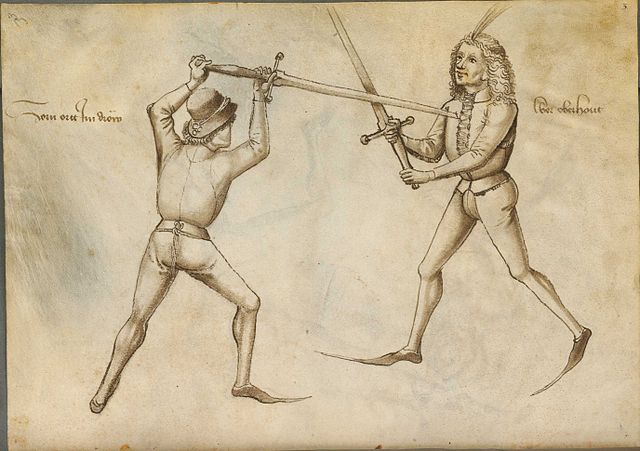

Attacking with Longswords
The Liechtenauer tradition speaks of the Three Wounders (Drei Wünder): The strike, the thrust, and the slice.
- The Strike: The strike is used to make a hard cut with percussive momentum. The dominant hand guides the blade in its direction, but the cutting power comes from the off-hand, which creates the leverage to get the tip moving faster. There are three main types of cuts: the over-cut (oberhau), the under-cut (unterhau), and the middle-cut (mittelhau).
- The Thrust: Because the tip is already pointed forward, the thrust is usually performed in the Plow or the Ox guards. As the sword’s tip extends in a straight line to the target, the body and feet follow afterward.
- The Slice: The edge is placed against an exposed area of the opponent’s body, then pulled or pushed with force to cut. The slice is of good use when there is no room to make a full cut.
Defending with Longswords
Movement is the most important element of defense. Voiding, or stepping out of the way of attacks, is a more efficient means of defense. Liechtenauer outlined five “secret” strikes to be used to set aside an opponent’s sword (the Strike of Wrath or Zornhau, the Cross Strike or Zwerchau, the Parting Strike or Scheitelhau, the Crooked Strike or Krumphau and the Squinting Strike or Schielhau, Each of them defends a different part of the body: torso, head, and legs.
Famous Longswords and Where to See Them
- The Guy of Warwick sword dates back at least to the 13th century and reputedly belonged to the legendary Guy of Warwick. He defeated the Danish giant Colbran to save the English Crown for King Athelstan, who reigned from 925 to 940. The sword is held at Warwick Castle.
- The Sword of Spiritual Justice dates from the early 17th century and is displayed at the Jewel House in the Tower of London. It probably supplied for the coronation of Charles I in 1626.
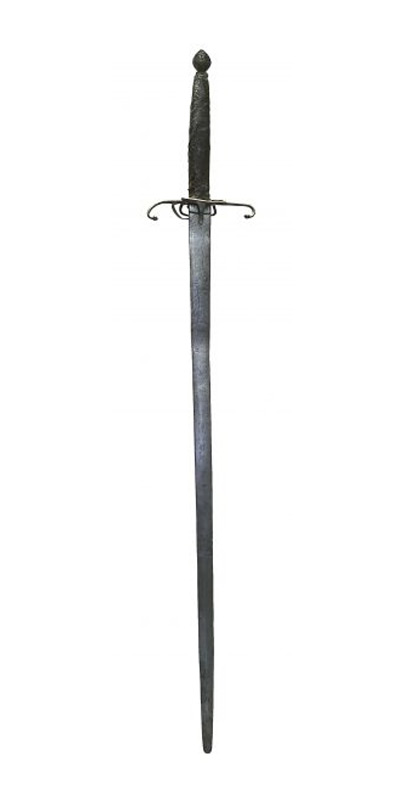

The Wallace Sword
The Wallace Sword is a two-handed sword purported to have belonged to William Wallace (1270–1305).



The Writhen Hilt Sword
The undeniable natural beauty of the Writhen Hilt Sword stands out amongst the many utilitarian swords of the late-15th century.
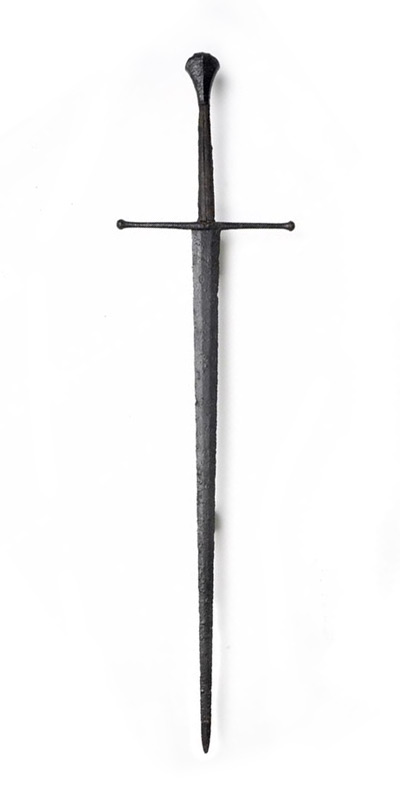

Longsword 39.142
This Longsword was found in the Thames near Kew, and probably dates from around 1450.

